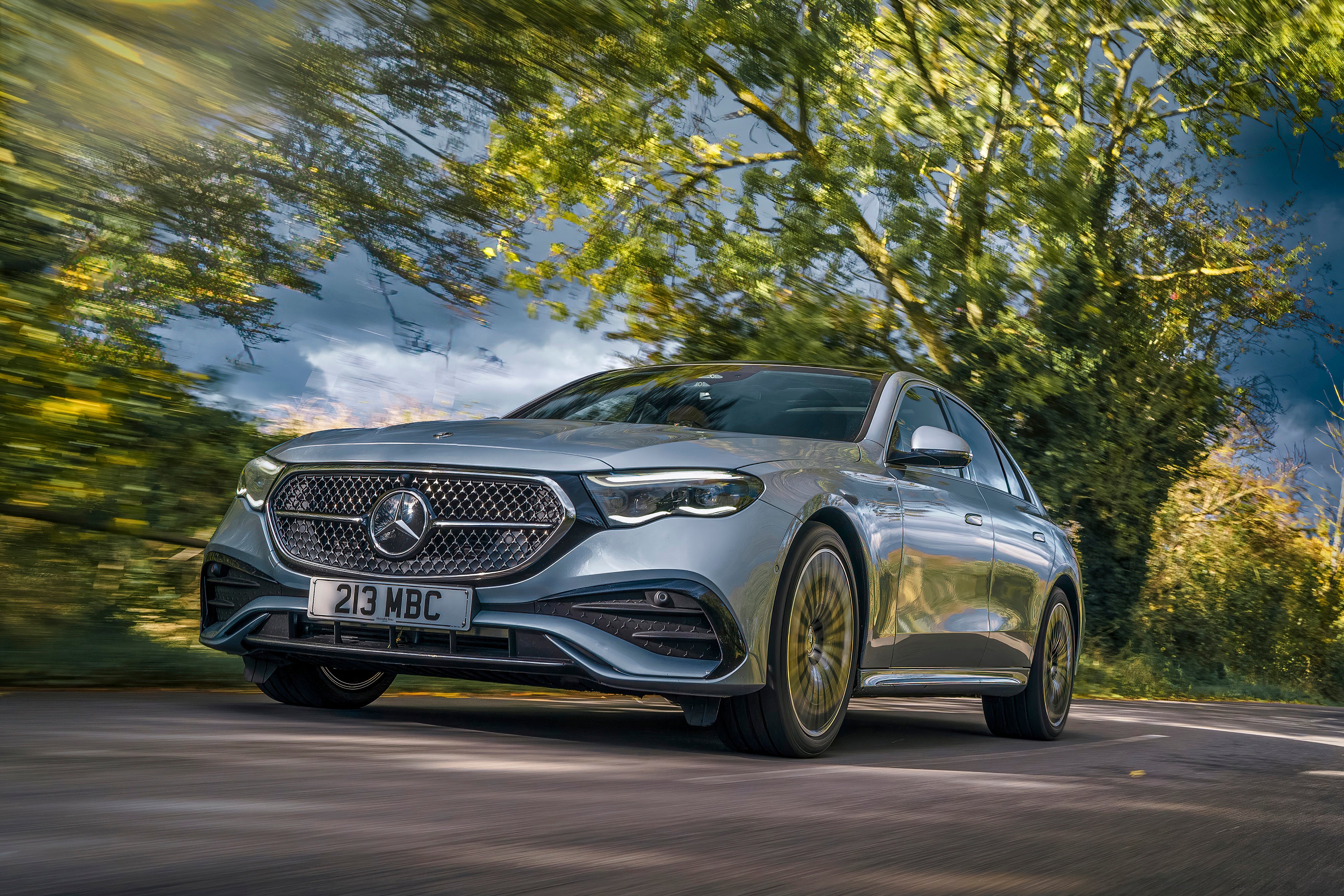Mercedes-Benz E-Class Review 2025: Price, specs & boot space
Written by Phill Tromans
Quick overview
Pros
- Excellent ride comfort and general refinement
- High-tech, feature-rich interior
- PHEV models have class-leading battery range
Cons
- PHEVs lose boot space over other versions
- BMW 5 Series is more fun to drive
- Pricey, especially when you add options
Overall verdict on the Mercedes-Benz E-Class
“The Mercedes-Benz E-Class brings together the comfort of a traditional executive car and the latest in modern technology. It has a wonderfully refined interior, cutting-edge infotainment and superb long-distance cruising ability. On the downside, it can’t touch the BMW 5 Series for driver engagement and agility, and the plug-in hybrid model, while technically impressive with a large battery range, sacrifices some practicality. These are minor drawbacks, however - overall the E-Class is a luxurious and high-tech choice for drivers (and passengers) that prioritise comfort and classiness.”
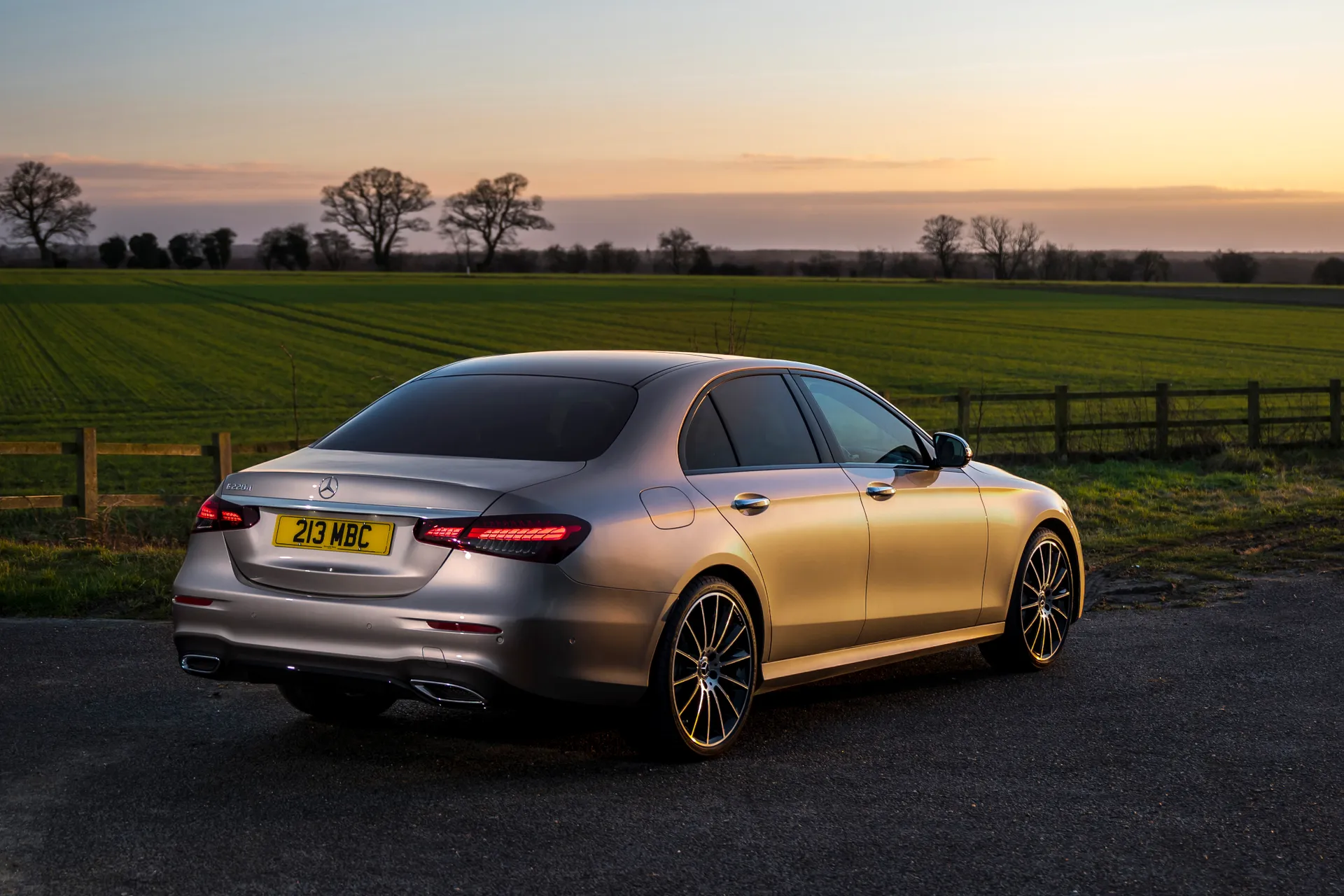
The latest E-Class continues Merc’s long tradition of excellent executive cars. Available with petrol, diesel and plug-in hybrid powertrains, it offers the kind of smooth and refined driving experience that one expects from the brand with the three-pointed star. The styling of this latest version is an evolution of those that have gone before, rather than a revolution, but the interior more than makes up for that with a slew of advanced features, such as the (optional) Superscreen that essentially turns the dashboard into a full-width multimedia experience.
Dynamically, the E-Class is nowhere near as sharp or agile as the BMW 5 Series. And, fancy as the Mercedes infotainment system is, the Audi A6’s setup is slightly more intuitive and sits in a particularly impressive cabin when it comes to material and build quality. However, the E-Class excels when it comes to a quiet, comfortable driving experience, and the plug-in hybrid models are particularly attractive with their low company car tax bills and high electric-only range.
Looking for a used car for sale? We've got 100s of Mercedes-Benz Approved Used Cars for Sale for you to choose from, including a wide range of Mercedes E-Class cars for sale.
Is the Mercedes-Benz E-Class right for you?
If you’re after a car that can cover vast distances in comfort and style, then the Mercedes E-Class is hard to beat. Its excellent refinement, luxurious interior and wealth of technology make it ideal for motorway cruising or daily commutes.
If, however, you’re after driving fun and engagement behind the wheel, there are better choices, namely the BMW 5 Series. There are performance options for the E-Class in the form of the powerful AMG model, and while we suspect they’ll be a lot more fun, we’ve yet to try them.
For those needing more space, there's the Mercedes E-Class Estate to consider.
What’s the best Mercedes-Benz E-Class model/engine to choose?
Our test car was the very impressive petrol-powered E300e plug-in hybrid, which has a superb electric-only range of up to 70 miles and a combined power output of 313PS. That large electric range means short-to-medium journeys can pass by with minimal fuel use, and only on the longest motorway schleps does the MPG start to dip as reliance on the petrol engine increases. It’s a very impressive powertrain – pricey up-front, but particularly attractive as a company car due to its low tax implications. A diesel plug-in hybrid – the E300de – is also available, which will be more efficient when you rely on the engine.
Those regularly covering longer journeys may find the regular diesel models more appealing. The E220d offers a great balance of economy and performance, promising up to 58.9mpg according to official figures, while the E450d has even more grunt from its straight-six engine and a 0-62mph time of less than five seconds. A petrol model – the E200 – is also available and is the most affordable version of the E-Class. It could be a solid option for all-round use, while the AMG performance model offers big power for a big price.
What other cars are similar to the Mercedes-Benz E-Class?
The big rivals for the E-Class are the German alternatives - the BMW 5 Series and the Audi A6, which both offer similar levels of luxury and practicality. A more left-field choice could be the more affordable but less impressive Genesis G80, while within the Mercedes range the EQE electric saloon occupies a similar space in the line-up, but with zero emissions.
The Jaguar XF and the Volvo S90 were rivals for the previous-generation E-Class, but both have since been discontinued. That said, there are plenty of nearly new examples of each on heycar.
Comfort and design: Mercedes-Benz E-Class interior
“Glitzy and very well put together, the E-Class has taken lessons from its electric siblings in how to put together a thoroughly modern interior. It’s packed with features, well made and catches the eye far more easily than its German rivals.”
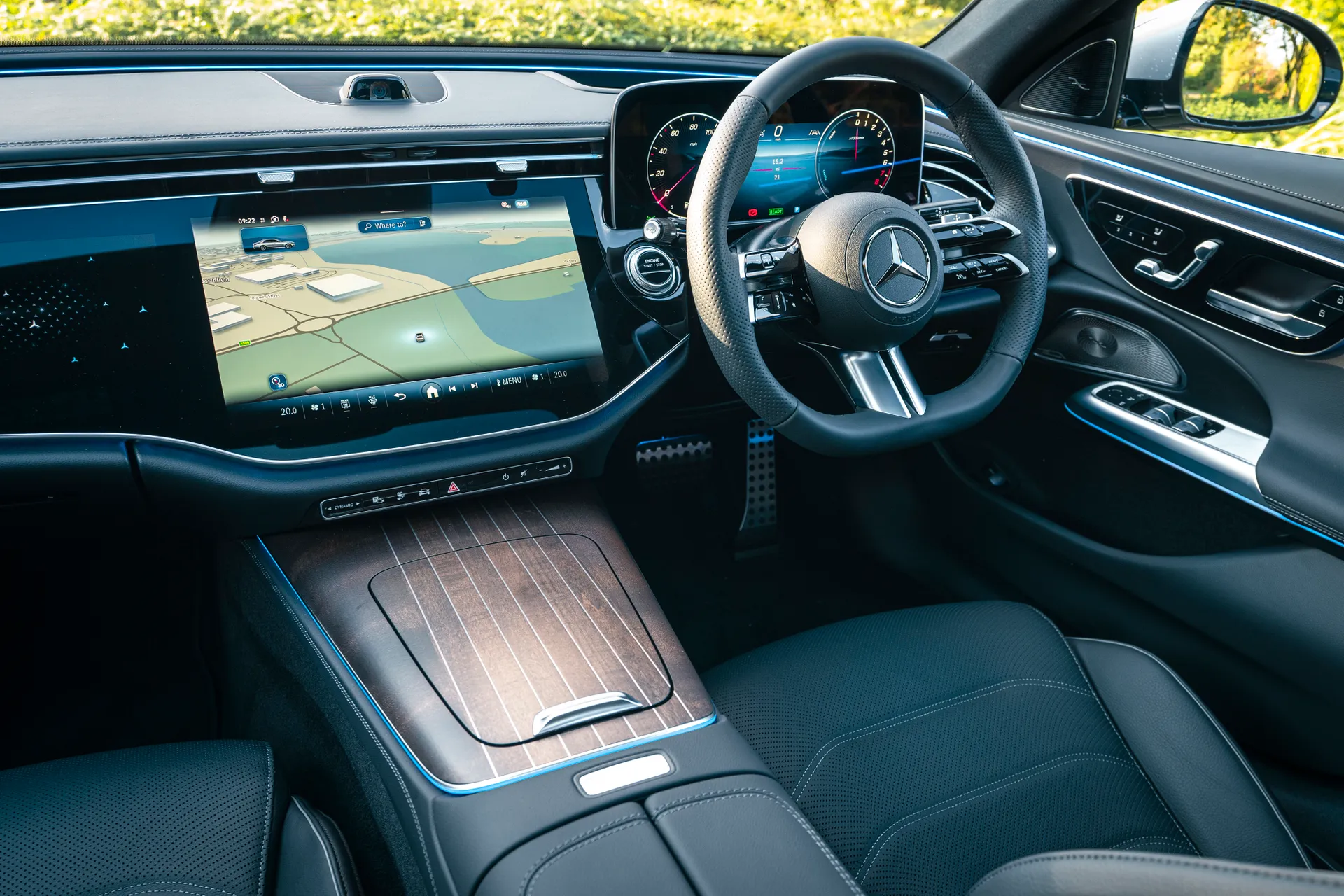
The E-Class interior is something of a technological tour de force, with a huge 14.4-inch touchscreen and an optional Superscreen that spans the entire dashboard. While it may divide opinion, the Superscreen adds a modern, high-tech feel to the cabin with its passenger display that houses apps and various entertainment features.
With excellent build quality and premium materials, as well as supportive front seats, it’s ideal for long journeys. There’s good space in the back, too, although the tallest rear-seat passengers may find their headroom compromised by the slightly sloping roofline.
Quality and finish
You expect a certain level of quality from a Mercedes, and the E-Class doesn’t disappoint. Luxury exudes throughout, with high-quality materials and rock-solid build.
Maybe the Audi A6 has a razor-thin edge when it comes to the tactility of the materials, that final edge of “thunk” when you close a door or the robustness of flaps, buttons and dials, but it’s very close and the Mercedes more than holds its own, especially with its innovative design and attention to detail. Merc went through a phase of slightly disappointing interiors after years of being top-notch, so it’s nice to see that era fading into obscurity and a return of genuinely high-end cabins.
Crank up the options list and you can upgrade the upholstery to various grades of leather, spec out the trim with open-pore wood, piano black lacquer or high-gloss metal, and AMG-related cars have lashings of carbon fibre.
Infotainment: Touchscreen, USB, nav and stereo in the Mercedes-Benz E-Class
Every E-Class is fitted with Mercedes’ MBUX infotainment system, with a 14.4-inch central touchscreen and a 12.3-inch driver display behind the steering wheel. The system is packed with features, so set some time aside to go through and understand what it can do, but it’s straightforward to navigate and quick to respond.
The Superscreen setup, which is optional on lower-spec cars and standard from AMG Line Premium onwards, is the centrepiece of the whole interior, meaning the whole front of the cabin is covered in screens with a third display added in front of the passenger.
Most interactions rely on the central touchscreen, which is responsive and easy to navigate, though the absence of physical buttons for quick access to key functions can be annoying. The system’s large icons help with usability but lack the intuitive feel of tactile controls, which are generally easier to operate while driving.
Touch-sensitive pads on the steering wheel are also provided for controlling infotainment features, but their performance is inconsistent. They often require multiple swipes to register your commands, which can be distracting. Traditional buttons would offer a more reliable and user-friendly experience. That said, the system as a whole is both visually appealing and functional.
There are four USB-C ports to plug mobile devices into – two in the front, two in the back – and both Apple CarPlay and Android Auto are supported. A wireless phone charger is integrated into a stowage tray in the centre console, and the AMG model gets a built-in dashcam.
Space and practicality: Mercedes-Benz E-Class boot space
The E-Class is a large car and has an impressive level of space and practicality. Up front, there’s lots of room although it feels cosy and cocooned thanks to the high centre console. The seats are very comfortable and supportive. There are numerous storage spaces, including a large compartment under the armrest for things like wallets or keys, and large door bins that can comfortably hold water bottles. The cupholders sit under a sliding cover in the centre console.
In the back, there’s loads of legroom – more than in the BMW 5 Series – although headroom can be tight for the tallest occupants because of the sloping roofline. The middle seat is best used for emergencies only, as the transmission tunnel down the side of the car impacts considerably on legroom. There’s a small storage compartment and two cup holders for rear-seat passengers.
In petrol and diesel models the boot has a 540-litre capacity, which makes the E-Class one of the most practical cars of its type. That’s plenty of space for luggage, shipping or miscellaneous business kit that needs hauling up the motorway. Being a saloon, the aperture at the boot opening is quite small for larger items. If you regularly need to carry larger items then the E-Class Estate could be a better option.
It’s worth noting that PHEV versions of the E-Class get a considerably smaller boot. The reduced 460-litre capacity is still far from tight, but the battery equipment under the boot floor impinges considerably and means there’s no underfloor storage for charging cables, either. The AMG model also loses boot space due to its own plug-in hybrid drivetrain, dropping the space further to just 370 litres.
Handling and ride quality: What is the Mercedes-Benz E-Class like to drive?
"The Mercedes E-Class is fantastic as a comfortable cruiser, with a smooth ride and minimal noise even at higher motorway speeds. Standard adaptive suspension keeps things cushy on rough surfaces, although we suspect it would be even more comfortable on the optional air suspension."
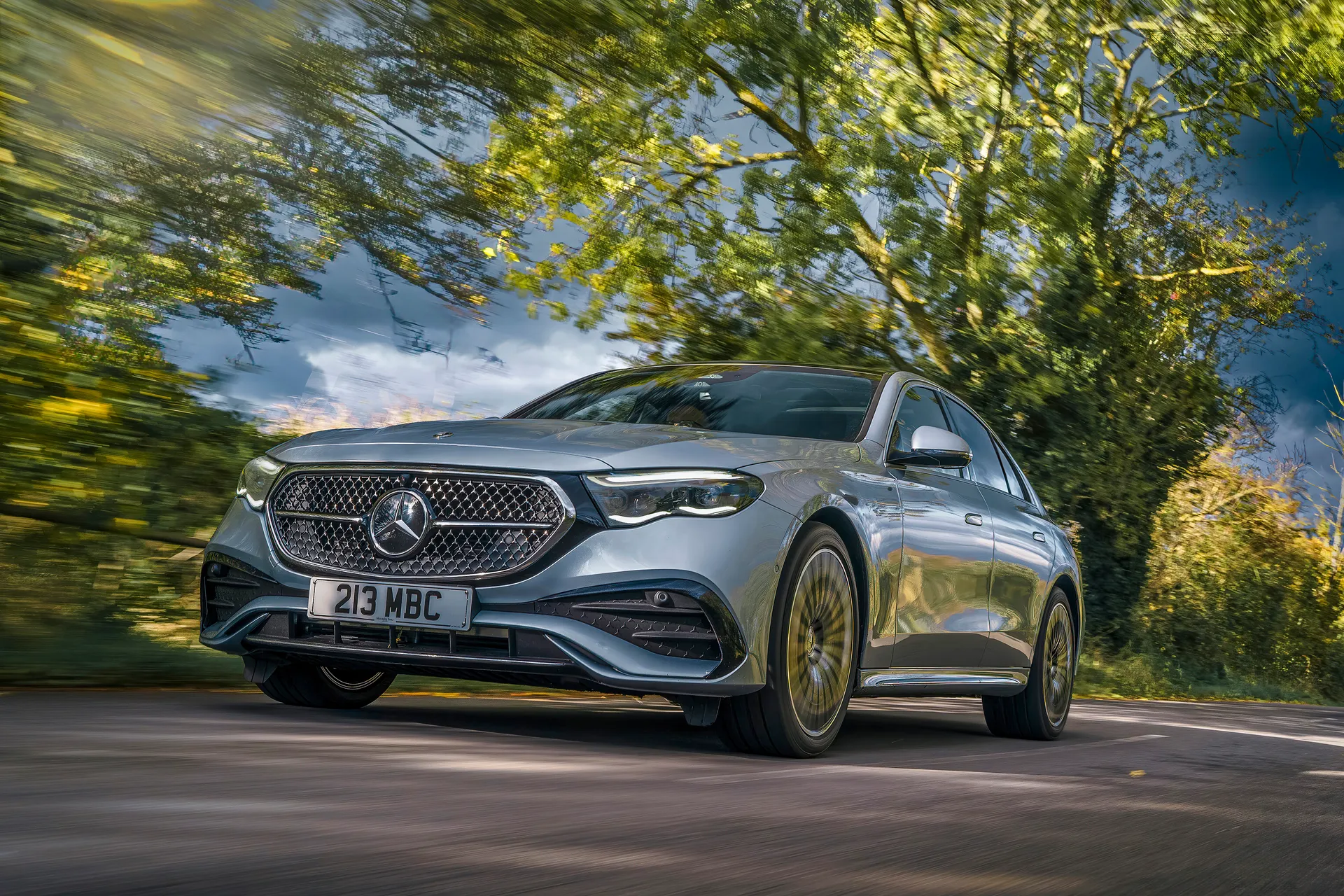
Calling the ride firm would be excessive, but it’s perhaps not quite as soft, pillowy and wafty as we’ve come to expect from luxurious Merc models.
When it comes to handling, the E-Class can’t boast the same dynamic feel as the BMW 5 Series, with less agility through the corners and less feedback through the steering wheel. You can push the pace if you wish, and the car stays confident when you do, but it doesn’t really excite you in the way that the BMW does. Much better to just sit back and relax.
That said, things are likely to be much more exciting in the AMG model, which as well as big power has sophisticated, stiffer suspension for much-improved handling. We’ve not had a chance to try this yet, but past experience has suggested it’ll be a major shift in character for the E-Class.
What engines and gearboxes are available in the Mercedes-Benz E-Class?
There’s a comprehensive range of powertrains for the E-Class, all of which use a smooth-shifting nine-speed automatic gearbox. The range starts with the sole petrol option, the E200, which has 204PS from a 2.0-litre engine and can reach 62mph from a standstill in 7.5 seconds. It uses a mild-hybrid system to boost fuel economy.
There are two mild-hybrid diesels to choose from. The E220d has a 2.0-litre engine with 197PS and can reach 62mph in 7.6 seconds, while the E450d 4MATIC model uses a 3.0-litre straight-six engine with 367PS for a 4.8-second 0-62mph time, helped by four-wheel drive instead of rear-wheel drive.
There are also two PHEVs to choose from. Both combine a 2.0-litre engine with an electric motor and battery to give an electric-only range of 70 miles, but the E300e runs on petrol and the E300de runs on diesel. The E300e puts out 320PS, while the diesel has 313PS. Both reach 62 mph in 6.4 seconds.
Then there’s the AMG model, officially called the Mercedes-AMG E53 Hybrid 4MATIC+. Equipped with all-wheel drive and a plug-in hybrid drivetrain, it uses a 3.0-litre petrol straight-six engine with 449PS and a 163PS electric motor, which deliver a 0-62mph time of 4.0 seconds. Despite its performance credentials, it can still run on electric power only for up to 62 miles thanks to its 21.2kWh battery.
In previous E-Class generations there’s also been a fire-breathing AMG E63, although a thusly designated model is yet to be confirmed for the current range.
Refinement and noise levels
The Mercedes E-Class is exceptionally quiet at motorway speeds, with minimal wind noise or road noise, except for a modicum of road noise at higher motorway speeds. Diesel models can sound slightly gruff under hard acceleration, but generally, the refinement is excellent, whatever type of driving you’re doing.
The Refinement section seems a good place to also mention the optional Refinement Package, which adds Airmatic air suspension with adaptive damping and is intended to smooth out the ride quality. It’s also available as part of the Technology Package. We’ve not had a chance to try it yet, but it should up the ride quality and increase the overall feeling of refinement – in theory, at least.
Safety equipment: How safe is the Mercedes-Benz E-Class?
Safety organisation Euro NCAP awarded the Mercedes E-Class a maximum five-star score when it was tested in 2024. It scored particularly highly – a mark of 92% – for adult occupant safety, and managed 90% for child occupant safety. In short, it’s a very safe car.
All models feature adaptive cruise control, blind-spot monitoring, lane-keeping assist and automatic emergency braking, as well as parking sensors and a reversing camera.
An optional Driving Assistance Plus package adds features like Active Lane Change Assist, which will automatically switch lanes for you. You can also upgrade the headlights and add a Parking Package that features a 360-degree camera system.
i-Size child seat attachments are included on the outer rear seats.
Mercedes-Benz E-Class MPG and fuel costs: What does it cost to run?
"Of the diesel engines, the most efficient is the E220d, which promises up to 58.9mpg according to official fuel economy figures, while the E450d, with its larger engine and all-wheel drive, drops that to 44.9mpg. The E200 petrol model promises up to 44.1mpg. "
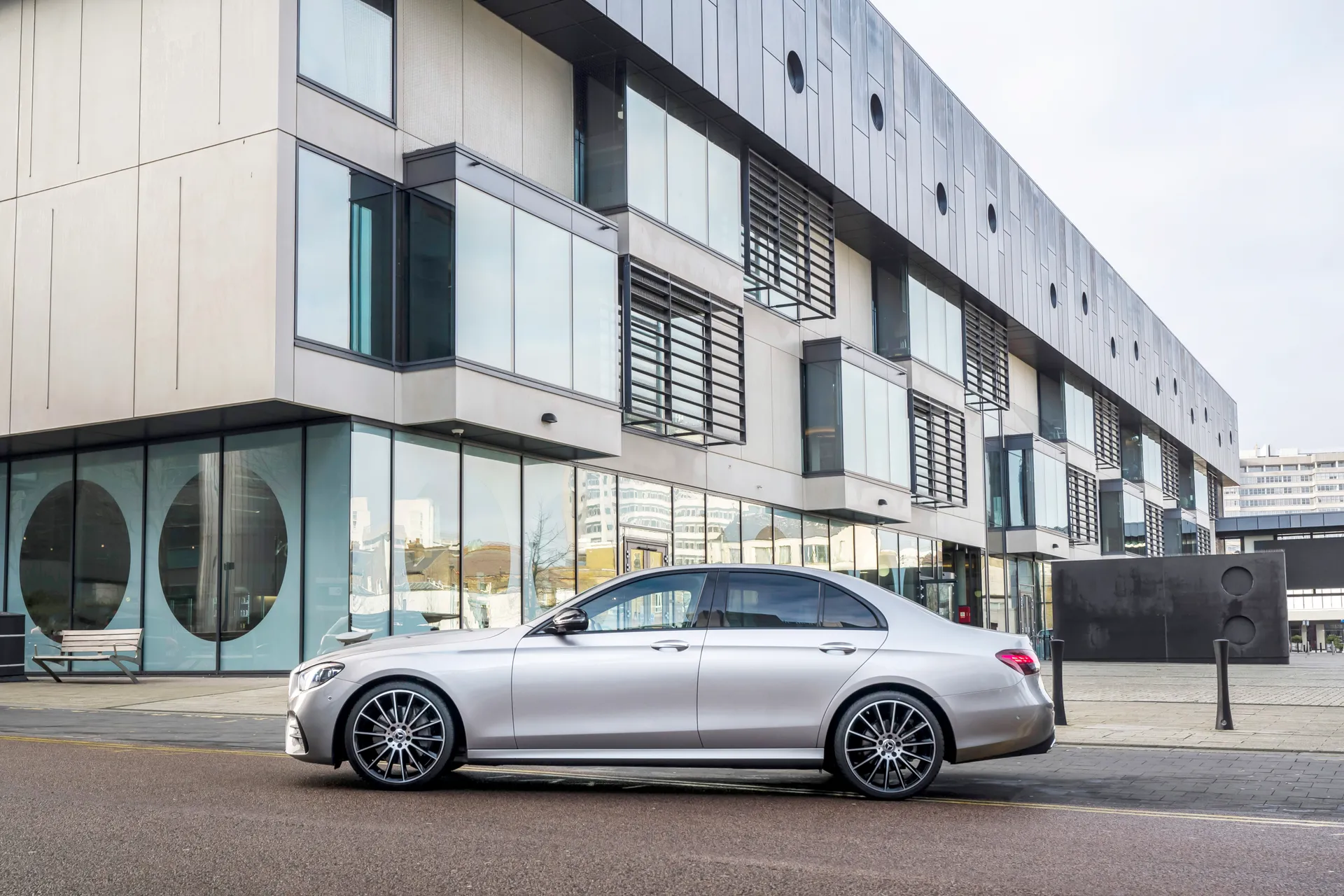
The official figures for the PHEVs are largely academic because their real-world fuel economy is hugely dependent on how they’re used and how much you rely on the battery. For the record, the E300e promises up to 470.8mpg and the E300de up to 706.3mpg. Both will manage up to to 70 miles on electric power only, with a full battery.
Running costs for the AMG model will likely be much higher due to its focus on performance over efficiency, but the fact that it’s also a PHEV does give the potential for efficiency when you’re not exploiting its power. It’ll run up to 62 miles on electric power alone and, officially, will return up to 31.7mpg.
Mercedes-Benz E-Class reliability and warranty
The latest E-Class is rather new so meaningful reliability data hasn’t yet been gathered. We hope it can perform better than previous generations, which had tended to rank slightly below rivals in independent reliability surveys. The warranty is a three-year, unlimited-mileage one, which is comparable to the model’s peers.
While we don’t want to overly worry you, Mercedes-Benz as a brand ranked fifth from bottom in the latest Honest John Satisfaction Index, which canvassed the opinions of 6,000 people over several aspects of car ownership, including reliability. Take heart, however, that Merc was at least ahead of fellow premium carmakers Porsche, Audi and Jaguar.
Mercedes-Benz E-Class insurance groups and costs
Depending on the model, the Mercedes E-Class sits in insurance groups 36 to 50 of 50. Its premium nature means it’ll be pricier than some other cars to insure, with the PHEVs and the AMG models particularly spicy when it comes to cost.
VED car tax: What is the annual road tax on the Mercedes-Benz E-Class?
You’ll pay a premium to tax an E-Class, because as well as the standard flat rate of annual Vehicle Excise Duty, you’ll also have to part with the expensive car surcharge due to all models costing more than £40,000 when new. That means a total of £600 a year, although PHEV models get a £10 discount.
The E200 d will cost you £540 for the first 12 months’ road tax and £475 for the following years. Most expensive of the lot is the AMG E63 that attracts a first yearly payment of £2175.
Mercedes-Benz E-Class price
"With an abundance of powertrain options on offer, how much you can pay for an E-Class varies wildly, with a starting price of £55,120 for the entry-level car and the AMG model potentially costing over £100,000 depending on the options added."
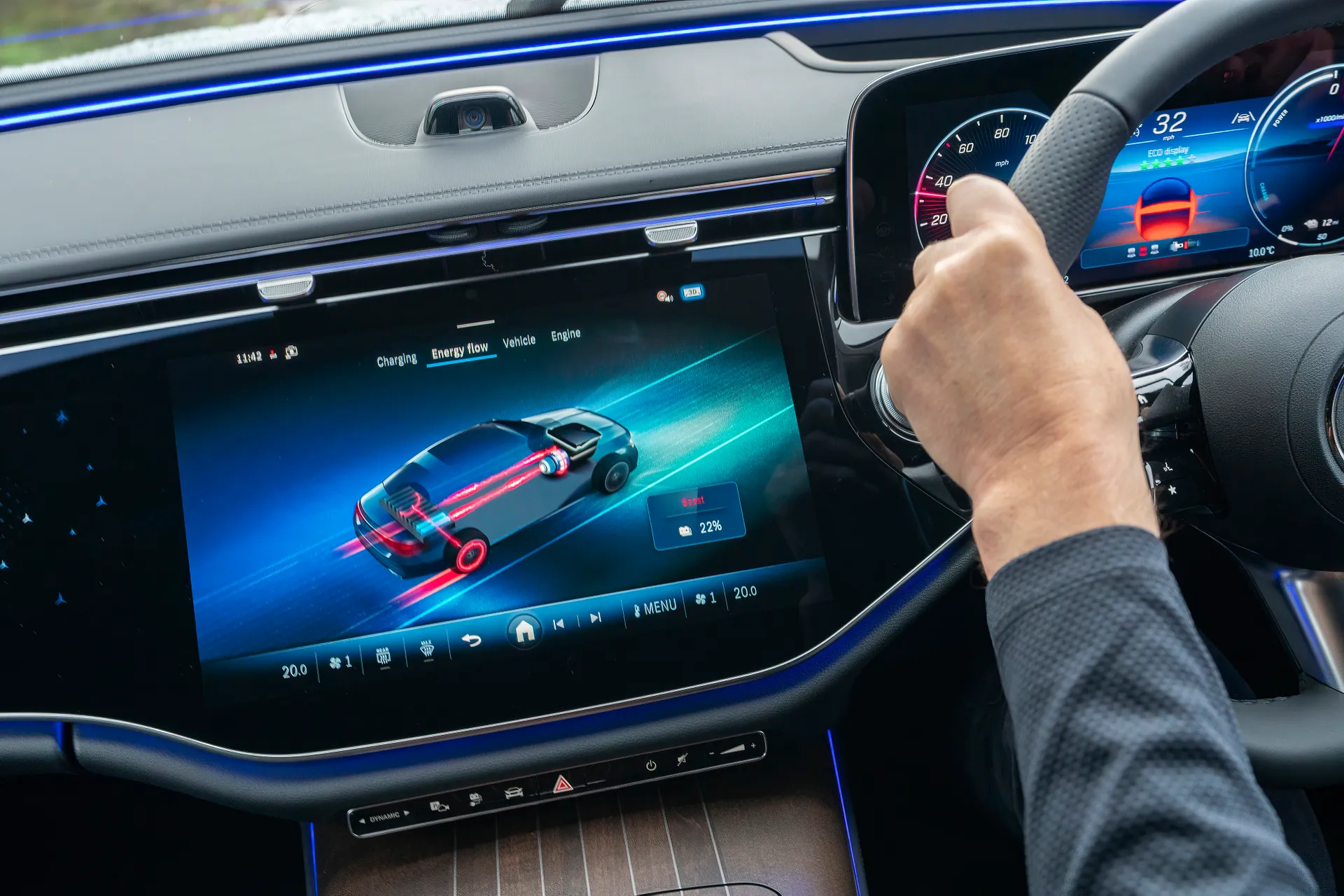
The E-Class kicks off the range at £55,120 for the E200 AMG Line, rising to £67,530 for the Exclusive Premium Plus trim. The E220d costs between £56,820 and £68,870, while the E450d 4MATIC, which is only available in AMG Line Premium and above, will set you back between £79,280 and £86,280. The E300e costs between £64,610 and £76,610, while the diesel E300de is £2000 more expensive. The powerful Mercedes-AMG E53 4MATIC+ costs from £90,860.
The Mercedes E-Class is fairly new to the market, so used examples are so-far restricted to low mileage examples. The most affordable at the time of writing, in late 2024, was around £47,000 with 8000 miles on the clock. As always, ensure that any used car you’re looking at has been looked after and serviced on time – while most used E-Classes of this vintage will still be low on miles, it’s best to be vigilant.
Trim levels and standard equipment
There are a choice of trim levels in the Mercedes E-Class, broadly set around two themes – AMG Line and Exclusive. AMG Line trims are inspired in looks by the powerful AMG model, while Exclusive is less sporty, more classy in look and feel.
AMG Line is the standard spec, with sporty styling, 18-inch alloy wheels, LED headlights and Artico synthetic upholstery inside. AMG Premium builds on that by including 19-inch wheels and a panoramic sliding sunroof, with electric memory seats inside and a Burmester sound system. Keyless entry and engine-start is also included.
AMG Premium Plus adds more kit, including 20-inch wheels, upgraded headlights and more comfortable seats with a massage function, as well as a heated steering wheel, heated armrest and a head-up display. The Superscreen package is standard, too.
The Exclusive line starts with Exclusive Premium, which is a less sporty version of AMG Line Premium, with a chrome barred grille and similar equipment levels. Chrome details replace the black accents of the AMG Line model, with a different design of 19-inch alloys. Exclusive Premium has big 21-inch wheels.
There’s also the Urban Edition, which is available only as an E300e or an E300de. It sits on 20-inch alloy wheels with a black and silver finish, AMG Line bodywork with upgraded headlights, keyless entry, tinted windows and heated seats,
Ask the heycar experts: common questions
Is the Mercedes-Benz E-Class a good car?
Is the E-Class better than the C-Class?
Are the E-Class plug-in hybrid's MPG figures realistic?
Get our latest advice, news and offers
Keep me updated by email with the latest advice, news and offers from heycar.
By submitting you agree to our privacy policy
